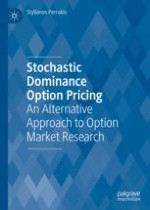2019 | OriginalPaper | Buchkapitel
4. Stochastic Dominance Option Pricing II: Option Bounds Under Transaction Costs
verfasst von : Stylianos Perrakis
Erschienen in: Stochastic Dominance Option Pricing
Aktivieren Sie unsere intelligente Suche, um passende Fachinhalte oder Patente zu finden.
Wählen Sie Textabschnitte aus um mit Künstlicher Intelligenz passenden Patente zu finden. powered by
Markieren Sie Textabschnitte, um KI-gestützt weitere passende Inhalte zu finden. powered by
